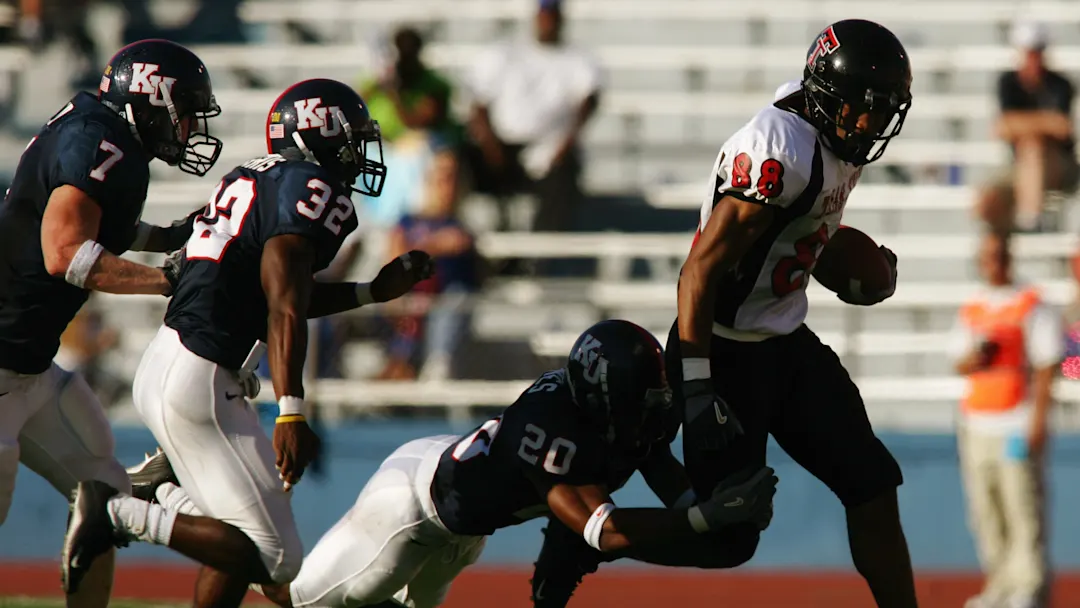When the 2004 college football season kicked off in Lubbock, Texas, not many outside of Raider Nation had Jarrett Hicks circled as a breakout star. That quickly changed. With every route he ran, every pass he hauled in, and every touchdown he scored, Hicks introduced himself not just to the Big 12, but to the entire college football landscape. As Texas Tech opened its campaign with high-flying expectations and a familiar air raid offense, Hicks didn’t just meet the moment — he exceeded it with an early-season stretch that would mark the beginning of one of the most memorable years by a Red Raider wide receiver.
A redshirt sophomore at the time, Hicks had already shown glimpses of his potential during the 2003 season. But 2004 was different. Now a featured weapon in Mike Leach’s famously pass-heavy system, Hicks exploded onto the scene with size, strength, hands, and poise beyond his years. Standing at 6-foot-4, the lanky and athletic receiver quickly became quarterback Sonny Cumbie’s favorite target — and for good reason.
In the opening game against SMU, Hicks made an immediate statement. With 150 receiving yards and two touchdowns, he didn’t just produce — he dominated. Defensive backs simply couldn’t match up with his physicality or read his precise routes. Hicks’ ability to stretch the field and make contested catches in traffic had the Red Raiders’ offense firing on all cylinders from the start.
And that was just the beginning.
As Texas Tech rolled into its early-season schedule, Hicks continued to post monster numbers. Against New Mexico, he tallied over 130 receiving yards, showcasing a rare blend of vertical speed and red-zone prowess. Week after week, the sophomore lit up opposing secondaries, helping propel Texas Tech’s offense to new heights. In a system built for receivers to thrive, Hicks thrived the most.
What made Hicks’ breakout so electrifying wasn’t just the numbers — though those were jaw-dropping in their own right. It was the way he played. With sure hands, sharp football IQ, and a relentless motor, Hicks became a nightmare for defensive coordinators. He could line up wide, go over the middle, or torch defenders deep. Every time Cumbie dropped back, the ball seemed destined for No. 88. And every time it did, magic followed.
Perhaps most impressively, Hicks didn’t just pad stats in blowouts. He showed up in the biggest moments. In a crucial early conference matchup against Kansas, he racked up 160 yards and two more touchdowns, helping Texas Tech secure a hard-fought victory. When the offense needed a spark, Hicks provided it. When Cumbie needed a go-to option, Hicks delivered. Consistently. Repeatedly. Dominantly.
By midseason, Jarrett Hicks had already surpassed the 800-yard mark and was among the top receivers in the country. His chemistry with Cumbie was undeniable, and his confidence only grew with each week. The national media began to take notice. Suddenly, Texas Tech wasn’t just known for its system — it was known for its superstar wideout who was taking that system to new levels.
Mike Leach, never one for hyperbole, praised Hicks as a “natural,” calling him one of the most disciplined and instinctive receivers he’d ever coached. That praise rang true in every game. Hicks ran routes with the precision of a veteran and had the hands of a future pro. Defensive backs tried pressing him at the line, only to get shrugged off. Others gave him cushion, only to watch him cut inside for 12-yard gains over the middle. There seemed to be no answer for his game.
What made the story even more compelling was Hicks’ journey to the spotlight. A product of Hightower High School in Missouri City, Texas, Hicks wasn’t the most heavily recruited athlete coming out of high school. But Texas Tech saw something in him — a raw talent with the frame and work ethic to develop into a star. And that’s exactly what he did. With dedication to the weight room, hours of film study, and the resilience to bounce back from early growing pains, Hicks transformed himself into a bona fide collegiate standout.
Off the field, Hicks was known as quiet and humble, a contrast to the swagger he played with on Saturdays. He rarely sought the spotlight, instead letting his game do the talking. But teammates and coaches raved about his leadership, his preparation, and the way he pushed everyone around him to be better. He was a competitor in every sense, and the 2004 season was his coming-out party.
As Texas Tech moved deeper into conference play, the stakes only got higher — and so did Hicks’ production. Against Nebraska, he posted another multi-touchdown game, torching the Cornhuskers for over 100 yards in a resounding Red Raider win. The game cemented his place as one of the most feared receivers in the Big 12.
The attention wasn’t just regional anymore. NFL scouts began circling his name. Analysts started projecting him on draft boards. Opposing coaches made him priority No. 1 in their defensive game plans — and still couldn’t stop him.
By the time the regular season drew to a close, Hicks had compiled one of the finest single-season performances in school history. With over 1,000 receiving yards and 13 touchdowns, he ranked among the nation’s elite. His impact went beyond the stat sheet. He opened up the offense for others, created mismatches across the field, and forced defenses to abandon their plans. He made Texas Tech’s air raid more dangerous than ever.
Yet even with all the accolades, Hicks remained grounded. In postgame interviews, he constantly deflected credit to his teammates, his quarterback, and his coaches. It was never about him — even when it was obviously about him. That humility, combined with his spectacular play, made him a fan favorite and a symbol of what Texas Tech football was striving to become under Leach’s guidance: tough, exciting, and impossible to ignore.
Hicks’ performance in the 2004 season laid the foundation for what would become a remarkable collegiate career. He returned in 2005 with even higher expectations and continued to dominate, solidifying his place among the Red Raiders’ all-time greats. But it was that breakout in 2004 — those early games where he simply could not be stopped — that made fans believe something special was happening in Lubbock.
In retrospect, the 2004 season wasn’t just a personal breakout for Hicks. It was a cultural shift for Texas Tech. It proved that elite receivers could rise from the shadow of system-based skepticism and demand recognition on a national scale. It proved that talent, when paired with preparation and opportunity, could ignite a fanbase and electrify a sport.
Today, nearly two decades later, Jarrett Hicks’ 2004 breakout still resonates with Red Raider fans. It was the year a quiet, hardworking wideout from Missouri City turned into a star. It was the year Texas Tech found a new offensive hero. And it was the year college football had no choice but to take notice of No. 88 — the big-play machine with soft hands, a fearless heart, and an unforgettable start.



